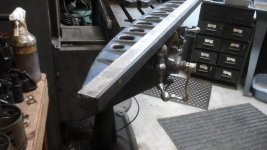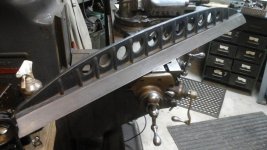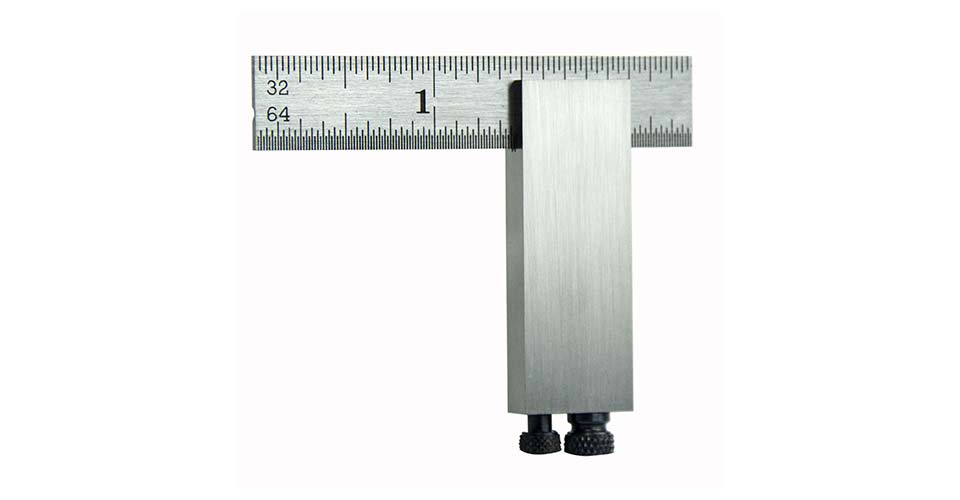M.B. Naegle
Diamond
- Joined
- Feb 7, 2011
- Location
- Conroe, TX USA
So I just got back from a week-long drive out to Georgia and back to visit family for the holiday. On the way there, I stopped by akajun's place in Louisiana and we struck a deal on the straight edges he had for sale on here (https://www.practicalmachinist.com/vb/tooling-parts-and-accessories-for-sale-or-wanted/48-scraping-straigtedge-dovetail-parrallel-blotter-sale-356582/#post3260052)
So the main one I was after was this 48" Parallel straight edge made by Challenge. I looks to have been a surface-ground one and I still need to check it out for squareness and parallelism, but my plan is to use it for machine inspection (levels, indicators, etc.), not printing. Given it's weight-to-length ratio and lack of a dovetail, I don't want to lug it around any more than to use it for things that your standard camelback straight edges can't do. Happy with the investment though! Even if it'll need to be reground or scraped into spec, it's a good core.

Now, for the point of this thread: He had these two straight edges he thought were for spreading ink, but I'm fairly certain are patterns. They don't have any identifying marks other than looking similar to some "unknown" straight edges than turned up via web search. The small one is an 18" with dovetail, and the big one is a 48" without dovetail. akajun has a finished 18" straight edge very similar to the small one but without the vertical ribs, and I also bought a 48" that looks like it was cast from the 48" pattern (casting defects match pattern defects), but someone milled the dovetail off of the pattern afterwards so it's now a non-dovetail pattern but has a very thick base. I'm thinking that the 18" pattern might have been made using akajun's straight edge as a pattern, and the foundry added the ribs. Does anyone know who might have had these pattern's made? Given the cost of pattern-making, I doubt someone made these just to do their own straight edges.
Just to be clear too: I don't plan on getting into casting straight edges anytime in the foreseeable future. IMO the market's not big enough to support any more makers than we already have, and these patterns don't look "special" compared to what's already out there. Just trying to fill in the blanks here.

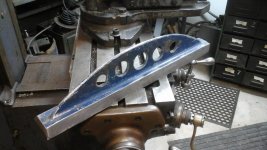

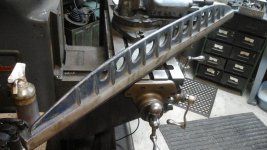
So the main one I was after was this 48" Parallel straight edge made by Challenge. I looks to have been a surface-ground one and I still need to check it out for squareness and parallelism, but my plan is to use it for machine inspection (levels, indicators, etc.), not printing. Given it's weight-to-length ratio and lack of a dovetail, I don't want to lug it around any more than to use it for things that your standard camelback straight edges can't do. Happy with the investment though! Even if it'll need to be reground or scraped into spec, it's a good core.

Now, for the point of this thread: He had these two straight edges he thought were for spreading ink, but I'm fairly certain are patterns. They don't have any identifying marks other than looking similar to some "unknown" straight edges than turned up via web search. The small one is an 18" with dovetail, and the big one is a 48" without dovetail. akajun has a finished 18" straight edge very similar to the small one but without the vertical ribs, and I also bought a 48" that looks like it was cast from the 48" pattern (casting defects match pattern defects), but someone milled the dovetail off of the pattern afterwards so it's now a non-dovetail pattern but has a very thick base. I'm thinking that the 18" pattern might have been made using akajun's straight edge as a pattern, and the foundry added the ribs. Does anyone know who might have had these pattern's made? Given the cost of pattern-making, I doubt someone made these just to do their own straight edges.
Just to be clear too: I don't plan on getting into casting straight edges anytime in the foreseeable future. IMO the market's not big enough to support any more makers than we already have, and these patterns don't look "special" compared to what's already out there. Just trying to fill in the blanks here.






